We’ve sent wheeled and tracked rovers to the moon and to Mars before, and as technology gets better, the images we get beamed back to us on Earth get correspondingly better. This time though, NASA is aiming for a true tech first: the first flight on another planet.
Attached to the under-belly of the Perseverance rover is the Ingenuity Helicopter, the tiny (it only weighs 1.8 kg) flying machine that’s going to answer the question of whether it’s possible to fly in the extremely thin atmosphere of Mars. Ingenuity has two 1.2 m diameter coaxial rotors, spinning in opposite directions on the same plane. It will have a maximum speed of 10 m/s, and will fly at between three and five metres above the surface of Mars.

Payload is a camera, facing down toward the red planet’s surface. All being well, the images that the helicopter sends back will reveal more detail on Mars’ terrain, including landing sites, and perhaps even little green men/microbes. Space being space, and engineering being engineering, NASA isn’t expecting great amounts of data from the camera; instead, they’re more interested in learning what they can about flight – if it’s even possible, for one; whether a coaxial helicopter is the best approach, and whether they’ve made the right assumptions about the effects of Martian gravity and atmosphere on flight characteristics. Although the gravity on Mars is only about one-third the strength that it is on Earth, the atmosphere is a lot thinner – the surface density of Mars is only 1% that of earth, meaning that it’s equivalent to flying 30,000 feet above the surface of Earth.
The maker connection
This is all great stuff, but what does it have to do with making? Well, the helicopter is a proof of concept, so NASA didn’t have tons of money to throw at it. Instead, they sourced as much as possible off the shelf – including the LIDAR-Lite v3 laser altimeter bought from SparkFun, for the princely sum of $130. For context, that’s 0.00016% of Ingenuity’s $80 m development budget.

Off-the-shelf components have two advantages over custom-made ones: the first, quite obviously, is the price. The second is less apparent, but it’s that they can be far more powerful than the equivalent custom piece. Big budgets take a long time to approve before any work gets done, so in the time it takes a branch of the US federal government to fund, commission, design, and build a given piece of hardware, the limits of what’s possible will inevitably have moved on.
Space age technology is all around us – Ingenuity uses a Qualcomm Snapdragon 801 processor – the same chip that’s used in smartphones, including the Google Pixel 4a. And it runs Linux, which is free to install whatever your budget. This is a truly fantastic time to be a maker – the toy box available to us has never been better. NASA certainly think so, and who are we to argue with that?







